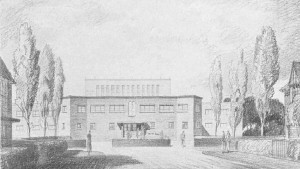Dvar Torah: What buildings can tell us
Written by Rabbi Josh Levy — 20 February 2015
Buildings say things about who we are. They communicate about our values, our self perception – about how we see our role in society.
This is nowhere more true than in the building of the Mishkan, the instructions for which Josh will read to us from tomorrow morning.
And it is also true in the building of synagogues. There was, especially in America, for example, a trend for big dramatic synagogues in the nineteenth century – communities wanted to be present and seen to be present – to impress non-Jewish neighbours by being part of society, with the best architecture. In the twentieth century, financial reality, and a stronger emphasis on integration, led to less visibly Jewish buildings. Buildings make statements.
So what does this say?
This is the first architects’ image of a new building, from the mid 1930s. A building ‘to be erected in a garden setting’ at the end of Alyth Gardens, adjoining Temple Grove
What do we notice, apart from the fact that
A. Alyth doesn’t look like this
B. there are no cars
C. they appear to have made Alyth Gardens a touch wider and given it some well manicures trees…
What strikes me straight away is that there is no fence, no gates. This is the mid 1930s – not a time when it was straightforward to be a Jew in Europe. And yet, the first image had no gates.
It is not possible – especially not these days, to look like this. We know that reality requires us to have fences, and guards, there are pressures we can not ignore. After last week’s events in Copenhagen, those pressures are greater still.
But it is important that we remember this as an aspiration. Our forebears in this community would not have wanted us to hide behind walls, but saw Alyth as part of the community around them. They wanted a shul open to the world.
At the moment this is not possible, and we feel vulnerable. But we should pray that one day we can realise their vision of a Jewish community without fences.

